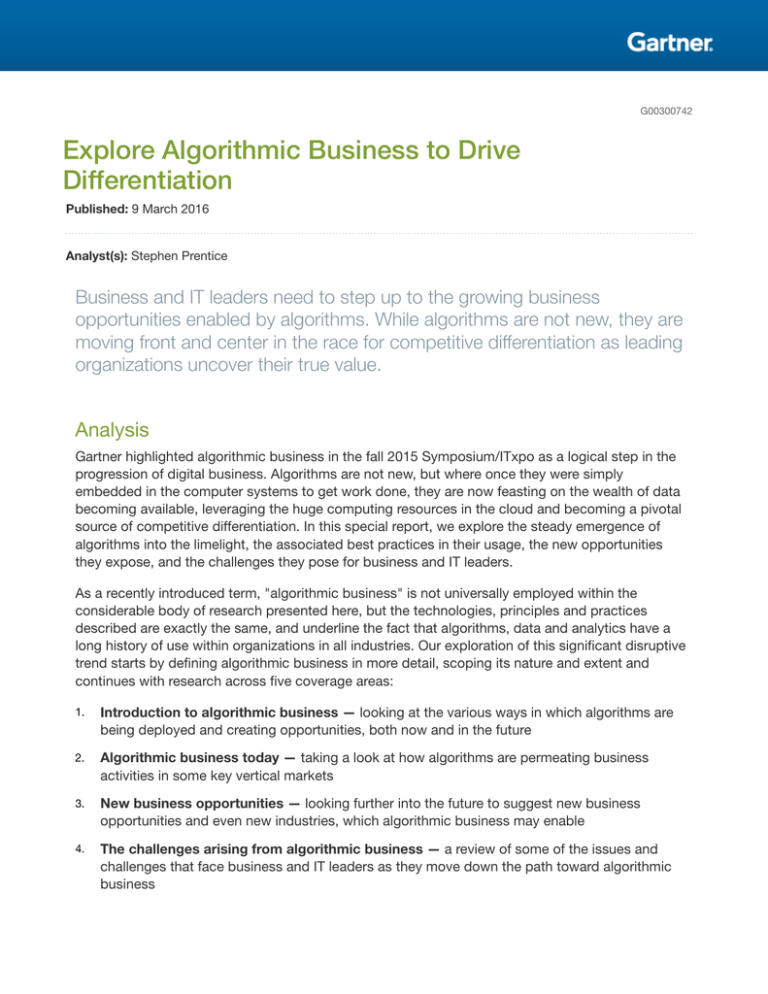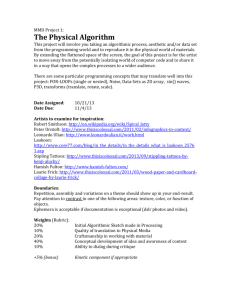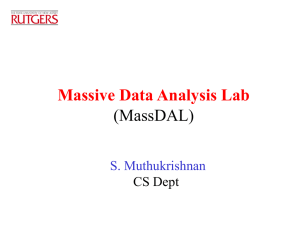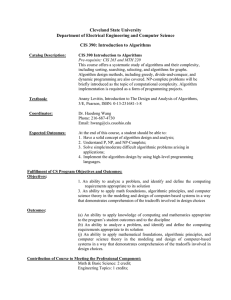
G00300742
Explore Algorithmic Business to Drive
Differentiation
Published: 9 March 2016
Analyst(s): Stephen Prentice
Business and IT leaders need to step up to the growing business
opportunities enabled by algorithms. While algorithms are not new, they are
moving front and center in the race for competitive differentiation as leading
organizations uncover their true value.
Analysis
Gartner highlighted algorithmic business in the fall 2015 Symposium/ITxpo as a logical step in the
progression of digital business. Algorithms are not new, but where once they were simply
embedded in the computer systems to get work done, they are now feasting on the wealth of data
becoming available, leveraging the huge computing resources in the cloud and becoming a pivotal
source of competitive differentiation. In this special report, we explore the steady emergence of
algorithms into the limelight, the associated best practices in their usage, the new opportunities
they expose, and the challenges they pose for business and IT leaders.
As a recently introduced term, "algorithmic business" is not universally employed within the
considerable body of research presented here, but the technologies, principles and practices
described are exactly the same, and underline the fact that algorithms, data and analytics have a
long history of use within organizations in all industries. Our exploration of this significant disruptive
trend starts by defining algorithmic business in more detail, scoping its nature and extent and
continues with research across five coverage areas:
1.
Introduction to algorithmic business — looking at the various ways in which algorithms are
being deployed and creating opportunities, both now and in the future
2.
Algorithmic business today — taking a look at how algorithms are permeating business
activities in some key vertical markets
3.
New business opportunities — looking further into the future to suggest new business
opportunities and even new industries, which algorithmic business may enable
4.
The challenges arising from algorithmic business — a review of some of the issues and
challenges that face business and IT leaders as they move down the path toward algorithmic
business
5.
How to deploy algorithms for business — a selection of best practices and more detailed
guidance of the next steps to take in the algorithmic business journey
Defining Algorithmic Business
Algorithms are a mechanism to capture knowledge and insight in a packaged form that can be
simply reused in a consistent fashion. At the simplest level, algorithmic business is about the
delivery of business value from algorithms and data, but this is a very broad description (see Figure
1).
Figure 1. Algorithmic Business
Source: Gartner (March 2016)
Business and IT leaders must focus more precisely on those instances where algorithms are not
only providing the insight, but also have become pivotal to competitive differentiation, and are
recognized for their value contribution. Perhaps the pinnacle would be Google's PageRank, the
algorithm that defines the company, but Amazon, Netflix, global retailers, airlines and financial
services organizations around the world have all realized the value that their algorithms deliver, and
are steadily taking steps to expand their use.
In "Defining Algorithmic Business," we present a more detailed description of what algorithmic
business is, what it delivers and why it is so critically important as organizations move steadily into
an increasingly digital age. It includes Gartner's definition of algorithmic business.
Page 2 of 10
Gartner, Inc. | G00300742
Algorithmic business is the industrialized use of complex mathematical algorithms
pivotal to driving improved business decisions or process automation for competitive
differentiation.
Research Highlights
We have broken this special report into five major segments: introduction, current examples of
usage, new business opportunities, challenges and a "how to" section.
Introduction to Algorithmic Business
In this segment, we provide a variety of background research to help business and IT leaders
understand the development — and ultimate confluence — of several trends that drove the
significant elevation of algorithms from embedded logic into powerful competitive weapons.
Our journey starts with the fall 2015 Gartner Symposium/ITxpo keynote, where Peter Sondergaard
first described the huge opportunities that algorithms enable as organizations seek to take digital
business to the next level. The core elements of this keynote are captured in "Rising to the
Challenge of Digital Business: Key Insights From the 2015 Gartner Symposium/ITxpo Keynote."
For CIOs and CDOs, Alan Duncan's "The 10 Things You Need to Know About Algorithmic Business"
provides a brief summary of the key factors.
The significant developments in and growth of "smart" machines are key factors in the way
algorithms emerged from the shadows and have become more easily accessible to every
organization. This area is the subject of significant research coverage, but we include here a
selection of key pieces to help tell the background story of the rise of algorithms to prominence:
■
In "Smart Machines See Major Breakthroughs After Decades of Failure," Gartner Fellow Tom
Austin charts the slow progress of artificial intelligence (AI) from the early days in the 1950s to
the recent surge in capabilities. He suggests that this developmental path heralds a new 75year era of smart machines.
■
In "Smarter Machines Will Challenge the Human Desire for Control," we outline some of the
issues and introduce some of the underlying models for decision support that helped develop
the structure of algorithmic business.
■
Algorithmic business is seen as a natural evolution in the ongoing development of digital
business, and in "When Smart Things Rule the World — Introducing Autonomous Business," we
extend the existing digital business development roadmap out to 2025 and beyond, where we
anticipate algorithms becoming increasingly capable and operating in an increasingly
independent manner on behalf of people and businesses — and possibly even themselves. To
Gartner, Inc. | G00300742
Page 3 of 10
clarify (since this piece was published before the concept of algorithmic business was
introduced), we view autonomous business as an advanced form of algorithmic business (which
is in itself a highly evolved form of digital business).
Perhaps not surprisingly, the technologies, trends and developments, which enable algorithmic
business, have been highlighted in many of the forward-looking predictions from across Gartner
research in the last few months, especially in the areas of digital business and analytics:
■
At the high level, "Predicts 2016: Algorithms Take Digital Business the Next Level" makes it
clear what a key role algorithms are expected to play in the development of digital business.
■
The transformational impact of algorithms on the evolution of more human- and businesscentric approaches to technology is explored in "Predicts 2016: Algorithms Shift the Focus to
Business- and Human-Centric Emerging Technologies."
Our coverage of algorithmic business (and how we expect it to evolve in the years to come) is only
just starting, and will feature prominently in our most forward-looking agenda, as outlined in
"Planning for What Comes After Digital Business Primer for 2016," as well as much more detailed
coverage in the more targeted agendas covering the analytics space.
Algorithmic Business Today
Algorithmic business as a term may be new, but the practical usage of the underlying principles and
technologies and the disruptive business models it enables are already established in many
industries and organizations. Examples include:
■
Healthcare: See "The Emergence of Precision Algorithms in Healthcare," where Laura Craft
describes the emergence of the open availability of advanced clinical algorithms, and the
abilities that these bring to enable healthcare delivery organizations (HDOs) to monetize their
information assets, and to access algorithms that would otherwise be beyond their reach.
■
Human resources: In "Algorithms Will Transform Talent Acquisition," Helen Poitevin
summarizes the impact of algorithms to evaluate candidates' suitability for specific roles, and
the positive and negative impacts this will have on the activities of HR leaders.
■
Retail: The retail sector has long been at the leading edge of analytics and the use of algorithms
to drive greater engagement and efficiency:
■
In "Predicts 2016: Digital Business Uproots Traditional Retail Revenue Generation," a
number of retail analysts make the point that "algorithms will become the most valuable
assets of the retailer that must be managed, protected and — at times — shared freely to
encourage innovation."
■
Research Director Robert Hetu looks at the use of algorithms in merchandising in
"Algorithmic Retailing: Merchandising Leads the Way."
■
Chris Fletcher describes best practices in "Best Practices in Price Optimization and
Management: Three Ways to Enable Algorithmic Business and Dynamic Pricing."
Page 4 of 10
Gartner, Inc. | G00300742
■
Hetu then summarizes the use of algorithms within applications for price optimization in
"Market Guide for Unified Price, Promotion and Markdown Optimization Applications."
■
Education: In "Analytics, Assessment and Adaptive Learning Will Prepare You for the
Algorithmic Education Revolution," Jan-Martin Lowendahl looks at how higher education CIOs
have a key role in solving the global challenge of a scalable, affordable and quality education by
mastering the "three As" as precursors of true algorithmic education.
■
Asset-intensive: In industries such as oil and gas, energy production, mining, infrastructure,
and so on, automation has already squeezed most of the potential efficiencies out of the
processes, product innovation is limited and these companies increasingly struggle to
differentiate themselves and mitigate operational risks. In "Algorithms Will Drive Success in
Asset-Intensive Industries," we explore how the digital business, and especially the use of
algorithms, is becoming the new battleground for differentiation.
New Business Opportunities
Digital business is already transforming organizations, disrupting industries and creating new
opportunities for organizations prepared to make the transformation. We confidently expect
algorithmic business will create even greater levels of disruption, more new business opportunities
and even new industries in the longer term. In this body of research within the special report, we
look out a little further toward the next decade to explore what may happen as the current trends
become more established.
In "Algorithm Marketplaces Are Bringing the App Economy to Analytics," Alex Linden highlights the
emergence of marketplaces for algorithms, and explains how these currently nascent marketplaces
are expected to transform software development and allow developers to monetize their intellectual
property, and the flexibility and opportunities this will bring for user organizations in the future.
The following research covers the ability of algorithms to disrupt existing business models:
■
In the forward-looking research "Maverick* Research: Multiply Value Creation With
Programmable Business Models," Kristen Moyer and Gary Olliffe suggest organizations will
need to deploy multiple business models that are shared, dynamic, dispersed and opportunistic
(and created with the use of algorithms) to keep pace with the rapid pace of disruption in the
future (see Note 1).
■
We confidently expect that algorithms will impact not only business models but also entire
industries. In "New Industries 2030: Virtual Talent Industry" (part of a collection looking at
potential new industries in 2030), we suggest how advances in technology will create a virtual
talent industry that will enable businesses to recruit smart algorithms, machines, robots and so
on to provide the expertise historically fulfilled by people.
One of the earliest well-publicized (and occasionally problematic) implementations of algorithmic
business was in the financial services sector, where algorithmic trading of stocks, foreign exchange
and commodities became a source of great competitive advantage for some organizations for a
Gartner, Inc. | G00300742
Page 5 of 10
period of time. Not surprisingly, we believe algorithms will continue to play a major role in creating
further disruption in the financial services sector in the longer-term future.
In "The Future of Money Is the Programmable Economy, Not Just Bitcoin," Gartner Fellow David
Furlonger proposes how the "programmable economy" — a highly developed future evolution of
algorithmic business — might develop, and the role that bitcoin (and other metacurrencies) will play
in transforming the digitally enabled business protocols in the future. In "Hype Cycle for the
Programmable Economy, 2015," Furlonger and Ray Valdes chart the progress of a number of critical
contributory technologies, including the key blockchain (an algorithm which is likely to have a
significant impact in the years to come) in the development of the programmable economy.
The Challenges Arising From Algorithmic Business
Amid the enthusiasm and hyperbole of any new technology, trend or development, there is always a
downside, and algorithmic business will be no different. Alongside the many advances and benefits,
there will be the inevitable problems and issues, both anticipated and unexpected. In this collection
of research, we explore the possible problems and advise on how they may be addressed.
We start with Ray Valdes' rather dark and apocalyptic exploration of what could happen, but keep in
mind that this is a piece of Maverick research wherein we take deliberately strong positions that
may be against prevailing modes of thought and action (see Note 1). In "Maverick* Research: Algos
Gone Wild — The Coming Apocalypse When Machine Intelligence Is Both Too Little and Too Much,"
Valdes suggests that the beneficial effects of algorithms on society may be nullified by
algorithmically driven systems antithetical to human interests.
Along a similar (but perhaps less extreme) vein, in "Maverick* Research: Your Smart Machine Has
Been Conned! Now What?" Patrick Hevesi, Anton Chuvakin and Erik Heidt look at the risks of
malicious humans using and abusing algorithms to achieve their goals. The authors focus on
identifying the possible risks, and how forward-looking IT and business leaders can prepare to
mitigate the risks and protect their organizations in the future.
Algorithms act on data, but the notion that data and analytics are unbiased is a fallacy. In
"Algorithms Are Biased — Here's How to Overcome This Inherent Data Problem," a number of
analysts provide their insight and provide a set of best practices in deliberate design and
implementation choices, in order to mitigate the potential effects of this bias.
One of the issues that has emerged with the growth of digital business is the increasing importance
and potential impact of digital ethics. In the digital world, this is no longer a hypothetical or
philosophical discussion but one where very serious problems can arise from often unintended
consequences of algorithms influencing and making decisions:
■
In "Create Smart Machines With Ethics in Their 'Minds,'" Frank Buytendijk and Whit Andrews
provide essential advice on the steps that CIOs and others should be taking today to ensure
that smart machines (and the algorithms that control them) behave ethically and deserve our
trust in the future.
■
In a drill-down into the area of dynamic pricing algorithms, in "Are Your Algorithms Ethical?
Look to Examples of Dynamic Pricing for Guidance," Buytendijk and others draw on real-world
Page 6 of 10
Gartner, Inc. | G00300742
experiences to show how business and IT leaders cannot rely solely on the technical
capabilities of algorithms — but must use judgment and exercise restraint in the deployment of
these technologies.
How to Deploy Algorithms for Business
In this final body of research, we draw on the experience and insight of many analysts to provide a
series of best practices, methodologies and frameworks to help guide business and IT leaders in
implementing the various elements of algorithmic business.
The pivotal role played by analytics in the practical realization of algorithmic business is made clear
in "Predicts 2016: Advanced Analytics Are at the Beating Heart of Algorithmic Business." In this
piece, Alan Duncan and other analysts explain how analytics leaders must now exploit new
business models and ecosystems to drive the operations of algorithmic business.
For those still in early stages:
■
Lisa Kart explains how getting started is as much about changing the mindset and culture as it
is about the technology — see "How to Take a First Step to Advanced Analytics" and "How to
Get Started With Prescriptive Analytics."
■
Building on the previously mentioned challenges of digital ethics and algorithms, Alan Duncan
and Frank Buytendijk advise analytics leaders in "How to Develop Analytics That Foster Trusted
Business Relationships."
■
Algorithmic business will be built on broader use of algorithms to first advise, and eventually
execute, decisions of increasing significance to the organization and other stakeholders. "Find
the Best Approach to Decision Management" reminds us that decisions are different to reports,
data discovery and analytics.
Analytics and decisions are one aspect of algorithmic business, but the insights from the algorithm
need to be put into action and the business outcomes captured, so that algorithms become part of
the cycle of business process experimentation. In "Make Business Operation More Agile With
Intelligent Business Processes That Reshape Themselves as They Run," Michele Cantara explores
how algorithms make it possible to individualize business processes in response to business
moments. Additionally, "Eight Dimensions of Process IQ Determine How Smart Your Process Needs
to Be" introduces IT leaders to the Gartner Process IQ framework, and provides a vocabulary for
identifying the types and degree of intelligence they need form the algorithms powering their
business processes.
Although algorithms will play an increasingly pivotal role in the future algorithmic business, many
algorithms will be hidden, embedded in packaged business applications. "Invisible Advanced
Analytics: Coming to a Business Application Near You" provides useful insight into both the
opportunities and challenges this raises for analytics and application leaders.
Gartner, Inc. | G00300742
Page 7 of 10
One of the major challenges for CIOs and IT leaders will be feeding the inexhaustible appetite of
advanced analytics for computing resources. Information architects and analytics leaders will need
to modernize their infrastructure to cope:
■
"Apply Gartner's Information Capabilities Framework to Achieve Algorithmic Business Success"
provides a core model for how to approach this challenge.
■
As algorithmic business develops still further, the drive for faster performance, greater scalability
and more real-time insight will require innovative architectures. "Predicts 2016: In-Memory
Computing-Enabled Hybrid Transaction/Analytical Processing Supports Dramatic Digital
Business Innovation" describes some of the advanced and emerging technologies that will help.
Like all key areas, governance in analytics will be critical to success. Thomas W. Oestreich and Joao
Tapadinhas provide valuable advice in "Best Practices for Driving Successful Analytics
Governance."
Inevitably security issues will become increasingly critical:
■
In "How to Build Your Own Big Data Security Analytics Capability," Anton Chuvakin provides
useful guidance on how (and why) some leading organizations are utilizing advanced analytics
algorithms and big data to create their own security analytics capabilities.
■
In "Managing Risk and Security at the Speed of Digital Business," Tom Scholtz explains how
digital business challenges the basic principles of information risk and security management,
and how security leaders must understand the risks associated with innovations like algorithmic
business and balance the conflicting demands.
Moving away from the issues to the more positive aspects of analytics:
■
Jamie Popkin explains how analytics and algorithms are playing an increasing role in
understanding the voice of the customer in "Sentiment Analysis Cracks the Code on
Unstructured Voice of the Customer Analytics."
■
"Predicts 2016: Smarter Collaboration via Algorithms and People-Centric Design" explores how
algorithms and advanced analytics will reshape collaboration strategies.
Moving then toward the broad business trends, "CIOs Should Embrace the Aims of Industrie 4.0 as
a Cornerstone of Algorithmic Business" shows how support for broad industry initiatives like
Industrie 4.0 (a German Federal Government sponsored initiative to create smart manufacturing that
is gaining broader support as a framework for connected, smart products and systems) actually
aligns well with the evolution toward algorithmic business and provides a useful "big picture" of
what will be required and the business benefits that will accrue.
Algorithmic Business Will Demand New Talent
We end this body of research by looking at the critical issue of staffing and skills. With the requisite
skills and resources currently in short supply and the challenges in recruiting for the new roles
required for algorithmic business in the next few years, staffing and skills is becoming a growing
major challenge.
Page 8 of 10
Gartner, Inc. | G00300742
■
In "Match Talent Profiles to Algorithmic Business Ambitions," Gartner Fellows Diane Morello and
Hung LeHong provide valuable insight on the emerging skills expected to be essential for
success in algorithmic business and how and where to find them.
■
In "Staffing the Office of the CDO," analysts Mario Fabio and Debra Logan look at the broad
issues facing the chief data officer attempting to accomplish a broad remit with limited
resources.
■
Finally, Gartner Fellow Mark Raskino describes in "Techquisitions: An Uncommon Approach
Some CEOs Use for Digital Business Acceleration" one approach being explored by senior
executives in some industries to close the skills gap faster — acquiring technology companies.
Gartner Recommended Reading
Some documents may not be available as part of your current Gartner subscription.
"Entering the Smart-Machine Age"
"Creating Net-New Industries for the World in 2030"
"The Six Forces That Will Shape Business and Technology in 2030"
"Maverick* Research: The Programmable Economy Is the Ultimate Destination for Digital Business"
Note 1 Gartner Maverick Research
"Maverick" research is designed to spark new, unconventional insights. It is unconstrained by our
typical broad consensus-formation process to deliver breakthrough, innovative and disruptive ideas
from our research incubator.
Gartner, Inc. | G00300742
Page 9 of 10
GARTNER HEADQUARTERS
Corporate Headquarters
56 Top Gallant Road
Stamford, CT 06902-7700
USA
+1 203 964 0096
Regional Headquarters
AUSTRALIA
BRAZIL
JAPAN
UNITED KINGDOM
For a complete list of worldwide locations,
visit http://www.gartner.com/technology/about.jsp
© 2016 Gartner, Inc. and/or its affiliates. All rights reserved. Gartner is a registered trademark of Gartner, Inc. or its affiliates. This
publication may not be reproduced or distributed in any form without Gartner’s prior written permission. If you are authorized to access
this publication, your use of it is subject to the Usage Guidelines for Gartner Services posted on gartner.com. The information contained
in this publication has been obtained from sources believed to be reliable. Gartner disclaims all warranties as to the accuracy,
completeness or adequacy of such information and shall have no liability for errors, omissions or inadequacies in such information. This
publication consists of the opinions of Gartner’s research organization and should not be construed as statements of fact. The opinions
expressed herein are subject to change without notice. Although Gartner research may include a discussion of related legal issues,
Gartner does not provide legal advice or services and its research should not be construed or used as such. Gartner is a public company,
and its shareholders may include firms and funds that have financial interests in entities covered in Gartner research. Gartner’s Board of
Directors may include senior managers of these firms or funds. Gartner research is produced independently by its research organization
without input or influence from these firms, funds or their managers. For further information on the independence and integrity of Gartner
research, see “Guiding Principles on Independence and Objectivity.”
Page 10 of 10
Gartner, Inc. | G00300742




